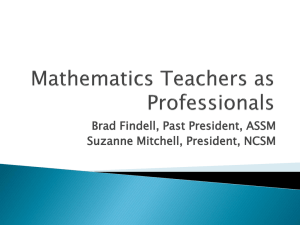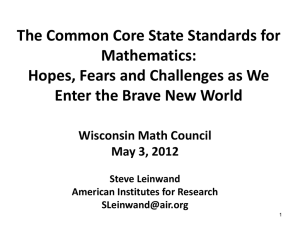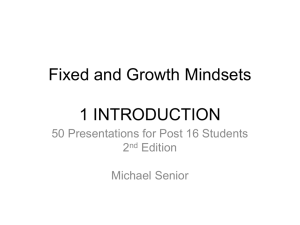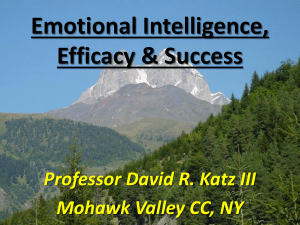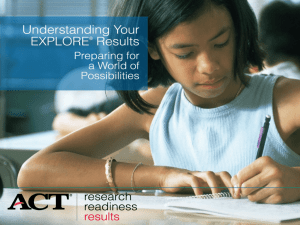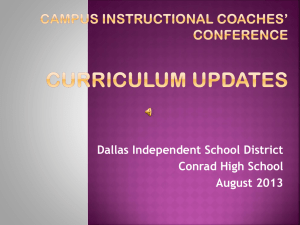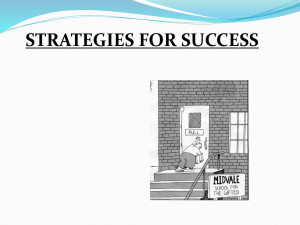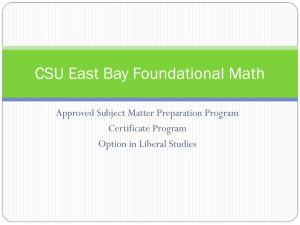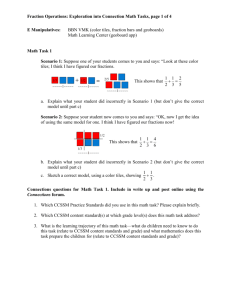Tilling the Soil for the CCSSM: Ten Essential Math
advertisement
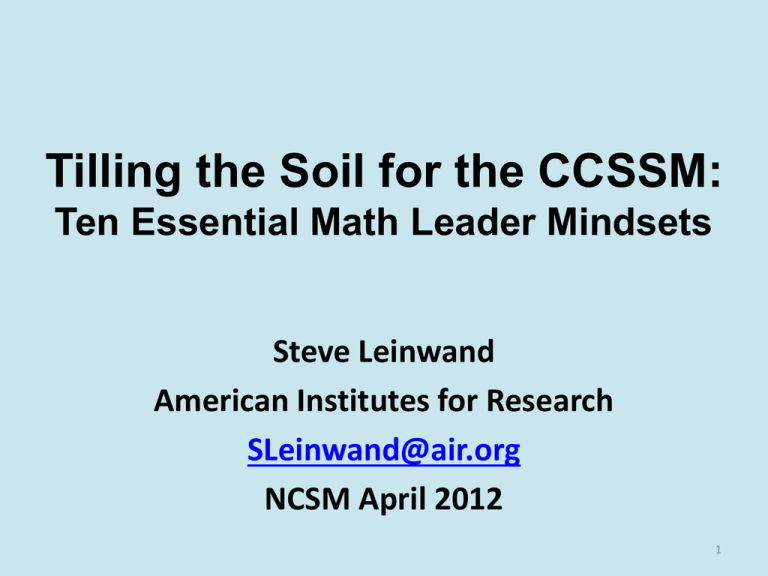
Tilling the Soil for the CCSSM: Ten Essential Math Leader Mindsets Steve Leinwand American Institutes for Research SLeinwand@air.org NCSM April 2012 1 Today’s purpose: • • • • • Part pep talk Part exhortation to action Part to-do list for leaders Part perspective building Part clarification to better align our efforts (heads on straight?) 2 An introductory aside OR Why these NCSM meetings are so important: - The 9-12 CCSSM are neither fewer, internationally benchmarked, nor good enough. - It’s time to plan funerals for Grade 8 Algebra 1. Ergo: validation of our opinions. 3 A Mindset • The ideas and attitudes with which a person approaches a situation, especially when these are seen as being difficult to alter. • In decision theory and general systems theory, a mindset is a set of assumptions, methods or notations held by one or more people or groups of people which is so established that it creates a powerful incentive within these people or groups to continue to adopt or accept prior behaviors, choices, or tools. 4 Carol Dweck • In a fixed mindset, people believe their basic qualities, like their intelligence or talent, are simply fixed traits. They spend their time documenting their intelligence or talent instead of developing them. They also believe that talent alone creates success—without effort. They’re wrong. (Who you know who best illustrates this?) • In a growth mindset, people believe that their most basic abilities can be developed through dedication and hard work—brains and talent are just the starting point. This view creates a love of learning and a resilience that is essential for great accomplishment. Virtually all great people have had these qualities. (Our aspirations) NCSM members need to adopt and cultivate growth mindsets if we are to till the soil for the Common Core! 5 Full disclosure For better or worse, I’ve been drinking the CCSSM Kool-aid. Leinwand on the CCSSM in the 2011 Heinemann catalog. 6 A Long Overdue Shifting of the Foundation For as long as most of us can remember, the K-12 mathematics program in the U.S. has been aptly characterized in many rather uncomplimentary ways: underperforming, incoherent, fragmented, poorly aligned, unteachable, unfair, narrow in focus, skill-based, and, of course, “a mile wide and an inch deep.” Most teachers are well aware that there have been far too many objectives for each grade or course, few of them rigorous or conceptually oriented, and too many of them misplaced as we ram far too much computation down too many throats with far too little success. It’s not a pretty picture and helps to explain why so many teachers and students have been set up to fail and why we’ve created the need for so much of the intervention that test results seem to require. But hope and change have arrived! Like the long awaited cavalry, the new Common Core State Standards (CCSS) for Mathematics presents us with a once in a lifetime opportunity to rescue ourselves and our students from the myriad curriculum problems we’ve faced for years. 7 Kool-aid (for you youngsters) • The flavored crystals you mix with water and put in the large pitcher because it’s cheaper than soda. • As in Tom Wolfe’s “The Kool-aid Acid Test”, the liquid used to mix the LSD among Ken Kesey and the Merry Pranksters. • The liquid Jim Jones and his cult members used to ingest the mass suicidal poison. In all three cases, nothing to be proud of. 8 Checker Finn for the Conservatives Supporters of the Common Core, ourselves included, peer out across this vast nation and see a hodge-podge of standards, tests, textbooks, curriculum guides, lesson plans – little of it of high quality or particularly “innovative” (with much of the “innovative stuff” being faddish and silly) and none of it aligned with much else in any meaningful sense. We look with some envy at other countries that can boast curricular “coherence” – a clear vision of what students should know and be able to do, a reasonable plan for getting teachers trained to impart it, and rich materials to help students and teachers reach the Promised Land. Attaining consensus of the standards and the assessments – the core part of the Common Core’s work – is a huge leap forward. 9 So what are the mindsets that till the soil to allow the CCSSM to take root and flourish? 10 #1: The Efficacy Mindset • The capacity for producing a desired result or effect • “If not me, who?” • “Sure we all have a role to play, but I can take the lead.” • “I have the knowledge, skills, commitment and courage to make a difference.” 11 • Hear yourselves: “Most of the people I work with either can’t or won’t provide the necessary leadership to support the implementation of the Common Core.” Then think: “That is why I have to provide the leadership that nurtures the capacity in others.” • Taking the standards to heart: Truly believing these are promises we intend to keep. 12 Promises These Standards are not intended to be new names for old ways of doing business. They are a call to take the next step. It is time for states to work together to build on lessons learned from two decades of standards based reforms. It is time to recognize that standards are not just promises to our children, but promises we intend to keep. — CCSS (2010, p.5) 13 #2: The Urgency Mindset • “This is truly a once-in-a-lifetime opportunity and we can’t afford not to get it right.” • “Every bone in our bodies says this too will pass, but this time, it can’t be another passing fad.” Why such urgency? 14 Urgency • Look at what we profess: – To make math work for ALL – To ensure every student is college or career ready • Look at what we know: – Can’t happen with existing curriculum – Can’t happen with existing instruction – Can’t happen with existing materials – Can’t happen with existing tests – Can’t happen with existing professional isolation 15 Urgency • Look at the hope: – – – – Curriculum: fairer, more coherent, fewer Instruction: skills AND concepts, practices Materials: they will produce what we will buy Assessments: PARCC/SBAC • A systemic approach as opposed to more tweaking at the margins Ergo: CCSSM as a brave-new-world game changer if only we can pull it off 16 #3: It Takes Time Mindset • Look at the progression: Awareness Familiarity Understanding Initial Forays Partial Implementation Institutionalization • But when have we ever had 4 years to change? • So let’s use it wisely 17 Rollout Timeline • 2010-11: A year of comprehensive planning (clarifying what needs to be done when) • 2011-12: A year of study (analyzing crosswalks, curricular implications, policy shifts) • 2012-13: A year of piloting and collaborative discussions • 2013-14: A year of curriculum and policy implementation and an assessment moratorium • 2014-15: A year of accountable implementation Where is your written plan? Where do you currently stand? 18 #4: It’s the MATH Mindset • Fewer, clearer, higher • Fairer – rational grade placement of procedures • NCTM processes transformed into mathematical practices • Learning trajectories or progressions • Spirals of expanding radius – less repetitiveness and redundancy • A sequence of content that results in all students reaching reasonable algebra in 8th grade • Balance of skills and concepts – what to know and what to understand 19 Crosswalks (what every teacher needs to know) • Exactly which and what proportion of the CCSSM are fully and/or partially matched by existing standards at that grade – that is, what is essentially the same or superficially the same, but deeper; • Exactly which and what proportion of the CCSSM are fully and/or partially matched by existing standards at a different grade – that is, what has to be moved; • Exactly which and what proportion of the CCSSM are not matched by existing standards at any grade – that is, what is new content; and • Exactly which current state standards for any grade or course get moved to a different grade or are no longer expected to be taught. 20 CCSSM Grade 6 (pp. 41-45) Ratios and Proportional Relationships • Understand ratio concepts and use ratio reasoning to solve problems. The Number System • Apply and extend previous understandings of multiplication and division to divide fractions by fractions. • Compute fluently with multi-digit numbers and find common factors and multiples. • Apply and extend previous understandings of numbers to the system of rational numbers. Expressions and Equations • Apply and extend previous understandings of arithmetic to algebraic expressions. • Reason about and solve one-variable equations and inequalities. • Represent and analyze quantitative relationships between dependent and independent variables. Geometry • Solve real-world and mathematical problems involving area, surface area, and volume. Statistics and Probability • Develop understanding of statistical variability. • Summarize and describe distributions. 21 Grade 6: Understand ratio concepts and use ratio reasoning to solve problems. 1. Understand the concept of a ratio and use ratio language to describe a ratio relationship between two quantities. For example, “The ratio of wings to beaks in the bird house at the zoo was 2:1, because for every 2 wings there was 1 beak.” “For every vote candidate A received, candidate C received nearly three votes.” 2. Understand the concept of a unit rate a/b associated with a ratio a:b with b ≠ 0, and use rate language in the context of a ratio relationship. For example, “This recipe has a ratio of 3 cups of flour to 4 cups of sugar, so there is 3/4 cup of flour for each cup of sugar.” “We paid $75 for 15 hamburgers, which is a rate of $5 per hamburger.” 22 3. Use ratio and rate reasoning to solve real-world and mathematical problems, e.g., by reasoning about tables of equivalent ratios, tape diagrams, double number line diagrams, or equations. a. Make tables of equivalent ratios relating quantities with whole number measurements, find missing values in the tables, and plot the pairs of values on the coordinate plane. Use tables to compare ratios. b. Solve unit rate problems including those involving unit pricing and constant speed. For example, if it took 7 hours to mow 4 lawns, then at that rate, how many lawns could be mowed in 35 hours? At what rate were lawns being mowed? c. Find a percent of a quantity as a rate per 100 (e.g., 30% of a quantity means 30/100 times the quantity); solve problems involving finding the whole, given a part and the percent. d. Use ratio reasoning to convert measurement units; manipulate and transform units appropriately when multiplying or 23 dividing quantities. Have you thought about…. • Seminars or math discussions (what’s new?, tape diagrams or double number lines, a replications of 1/b of a whole, statistics, modeling) • Cross walks • Grade level meetings • Connections within and between standards • The progressions • Sensible pacing guides 24 #5: It’s INSTRUCTION Silly Mindset - Standards don’t teach, teachers teach - It’s the translation of the words into tasks and instruction and assessments that really matter - Processes are often as important as content - We need to give kids (and ourselves) a reason to care - Difficult, unlikely, to do alone!!! 25 Justifying the shift in instruction • They forget – so we need to more deliberately review; • They see it differently – so we need to accommodate multiple representations; • They approach it differently – so we need to elicit, value and celebrate alternative approaches; • They give ridiculous answers – so we need to focus on number sense and estimation; • They don’t understand the vocabulary – so we need to build language rich classrooms; • They ask why do we need to know this – so we need to embed the math in contexts. 26 How do I know a teacher of mathematics gets it and is providing opportunities for students to learn? 1. Frequent use of the following questions to create a classroom culture of justification and explanation: - Why? - How do you know? - Can you show us? - Who did it differently? - Can you explain your thinking? - Can you convince us? - How did you picture it? 2. Opportunities for students to critique the reasoning of other students based on seeking out alternative approaches (both correct and incorrect). 3. Frequent use of such open-ended questions as: - Tell the class what you see here. - What else do people see? - Can you convince us that the answer is correct? How do I know a teacher of mathematics gets it and is providing opportunities for students to learn? 4. Explicit attention to new terms and vocabulary that uses pictures, examples and a word wall. 5. Daily use of ongoing cumulative review warm-up problems to review and diagnose. 6. Daily use of exit slips to provide formative assessment of the success of every day’s lesson. 28 29 That is, instruction that: • Provides students with better access to the mathematics: – – – – Context Technology Materials Collaboration • Enhances understanding of the mathematics: – Alternative approaches – Multiple representations – Effective questioning 30 In other words, math that: • Empowers, rather than sorts; • Relates to students’ own experiences; • Is based on sense-making, not regurgitation; and • Expects students to find solutions to problems, not just answers to exercises. 31 Have you thought about…. • • • • • • • • Common vision statement Intensive work with principals Fighting for coaching Demanding opportunities for collaboration Insidemathematics.org Book study Videos PARCC/SBAC websites 32 Five down….Five to go Time for a rational thinking interlude 33 Rational thinking Interlude We can’t do it all. - No sane teacher finishes the entire text. - We’ve allocated the clusters into major and supporting/additional - We’ve allocated the HS standards into non-+ (math for all) and + (math for nerds) We need to allocate practices 1-4 into nonnegotiable and 5-8 (negotiable and later) 34 4 Non-negotiable Practices 1. Make sense of problems and persevere in solving them. 2. Reason abstractly and quantitatively. 3. Construct viable arguments and critique the reasoning of others. 4. Model with mathematics. 35 4 Negotiable Practices 5. Use appropriate tools strategically. 6. Attend to precision. 7. Look for and make use of structure. 8. Look for and express regularity in repeated reasoning. 36 Math for Normals and Nerds Grade Traditional Normal Integrated Normal Accelerated Nerd Double-up Nerd 6 6 6 6/7 6 7 7 7 7/8 7 8 8 8 Alg 1/Math 9 8 9 Alg 1 Math 9 10 Geom Math 10 Alg 2/Math 11 Geom/Alg 2 or Math 10/11 11 Alg 2 Math 11 Pre-calc Pre-calc 12 (Pre-college) (Math 12) Calc/Stat Calc/Stat 10% 5% 85% → Geom/Math 10 Alg 1/Math9 38 #6: The Coaching Mindset Visit some of the most effective schools in any district or state with me. One finds formal or informal coaching. Experienced teachers mentor new teachers. It is not uncommon for colleagues to observe colleagues teaching and then debrief these observations. There are frequent discussions about what worked, what did not work, and what adjustments might be made. Coaches co-plan and co-teach with, and critique the work of, colleagues. Teacher leaders orchestrate collaborative reviews of videotaped lessons and lead seminars around common readings. The debilitating professional isolation of most teachers does not exist. Instead, there is a common spirit of “We’re all in this together,” a respectful ethos of transparency, and a culture of professional sharing orchestrated by teacher leaders and coaches. 39 My coaching touchstones • Was there opportunity for the students to learn? Why and why not? • What evidence was there that the mathematics was in fact learned? • What worked and was worthy of praise? • What didn’t work and why? • What opportunities were missed? • What growth nugget can I end with or leave with the teacher? How often are these critical questions asked and answered? Why not? 40 A Coach’s Roles • • • • • • Provider of expert guidance and direction Provider of support and flak interference Co-teacher, co-planner, co-assessor Demonstrator/modeler Observer/complimenter/critiquer Convener/instigator/organizer of professional interaction among teachers (Almost makes teaching seem easy) 41 #7: The Collaboration Mindset Practice-based Professional Interaction • Professional development/interaction that is situated in practice and built around “samples of authentic practice.” • Professional development/interaction that employs materials taken from real classrooms and provide opportunities for critique, inquiry, and investigation. • Professional development/interaction that focuses on the “work of teaching” and is drawn from: - mathematical tasks - episodes of teaching - illuminations of students’ thinking 42 To collaborate, we need time and structures • • • • • • • Structured and focused department meetings Before school breakfast sessions Common planning time – by grade and by department Pizza and beer/wine after school sessions Released time 1 p.m. to 4 p.m. sessions Hiring substitutes to release teachers for classroom visits Coach or principal teaching one or more classes to free up teacher to visit colleagues • After school sessions with teacher who visited, teacher who was visited and the principal and/or coach to debrief • Summer workshops • Department seminars 43 To collaborate, we need strategies 1 Potential Strategies for developing professional learning communities: • Classroom visits – one teacher visits a colleague and the they debrief • Demonstration classes by teachers or coaches with follow-up debriefing • Co-teaching opportunities with one class or by joining two classes for a period • Common readings assigned, with a discussion focus on: – To what degree are we already addressing the issue or issues raised in this article? – In what ways are we not addressing all or part of this issue? – What are the reasons that we are not addressing this issue? – What steps can we take to make improvements and narrow the gap between what we are currently doing and what we should be doing? • Technology demonstrations (graphing calculators, SMART boards, document readers, etc.) • Collaborative lesson development 44 To collaborate, we need strategies 2 Potential Strategies for developing professional learning communities: • Video analysis of lessons • Analysis of student work • Development and review of common finals and unit assessments • What’s the data tell us sessions based on state and local assessments • “What’s not working” sessions • Principal expectations for collaboration are clear and tangibly supported • Policy analysis discussions, e.g. grading, placement, requirements, promotion, grouping practices, course options, etc. 45 Vehicles, not ends • • • • • • • • • • Task analysis Collaborative planning Co-teaching Lesson study Instructional rounds Records of practice Video analysis Learning communities Coaching Gallery teaching 46 Finally, never forget: It’s not a PLC that magically makes a difference. It’s the content of, and followup and change that emerges from, the professional sharing and interaction that enhances the day-in-and-day-out opportunities for kids to learn mathematics! 47 #8: The Intervention Mindset • • • • Kids will fall behind Kids will arrive with deficiencies Again, we can’t “fix” every year Intensive intervention: – More time – Best teachers – Best instructional practices – At K, 3, 6 and 9 48 Long Reach HS Howard County (MD) recognized that there were a significant number of 9th graders who were not being successful in Algebra 1. To address this problem, the county designed Algebra Seminar for approximately 20% of the 9th grade class in each high school. These are students who are deemed unlikely to be able to pass the state test if they are enrolled in a typical one-period Algebra I class. Algebra Seminar classes are: 49 • • • • • • • • • Team-taught with a math and a special education teacher; Systematically planned as a back-to-back double period; Capped at 18 students; Supported with a common planning period made possible by Algebra Seminar teachers limited to four teaching periods; Supported with focused professional development; Using Holt Algebra I, Carnegie Algebra Tutor, and a broad array of other print and non-print resources; Notable for the variety of materials and resources used (including Smart Board, graphing calculators, laptop computers, response clickers, Versatiles, etc.); Enriched by a wide variety of highly effectively instructional practices (including effective questioning, asking for explanations, focusing of different representations and multiple approaches); and Supported by county-wide on-line lesson plans that teachers use to initiate their planning. 50 #9: The Infrastructure Mindset We’ve got: Content standards for Mathematics We’ve got: Standards for Mathematics Practices Why don’t we have: Standards for Effective Implementation 51 Standards for Effective Implementation • Quality opportunities for all teachers of math to understand the implications of the CCSSM for changes in curriculum, instruction and assessment. • A shared vision of effective teaching and learning that is aligned with the mathematical practices. 52 Standards for Effective Implementation • An annotated video library of effective teaching of the standards. • Adequate time and structures for collaboration. • Adequate technological tools to enhance the teaching of mathematics. • Aligned materials with a sensible pacing guide. • Aligned benchmark or interim assessments. 53 #10: The Risk-taking Mindset While “nothing ventured, nothing gained” is an apt aphorism for so much of life, “nothing risked, nothing failed” is a much more apt descriptor of what we do in school. Follow in the footsteps of the heroes about whom we so proudly teach, and TAKE SOME RISKS 54 Mindsets #1: Efficacy – You can do it! #2: Urgency – It needs to be done now! #3: Time – It takes time. A lot of time! #4: Mathematics – Never forget the content! #5: Instruction – The heart of the matter always! #6: Coaching – All great artists and athletes…. #7: Collaboration – Impossible to do alone #8: Intervention – Not everyone falls into step #9: Infrastructure – System elements are key #10: Risk-taking – What leaders do to be a leader! 55 To Summarize • People won’t do what they can’t envision, • People can’t do what they don’t understand, • People can’t do well what isn’t practiced, • But practice without feedback results in little change, and • Work without collaboration is not sustaining. 56 ERGO: Our job, as professionals and as leaders, at its core, is to help people envision, understand, practice, receive feedback and collaborate around the letter and the spirit of the Common Core State Standards for Mathematics. Thank you! Sleinwand@air.org 57
